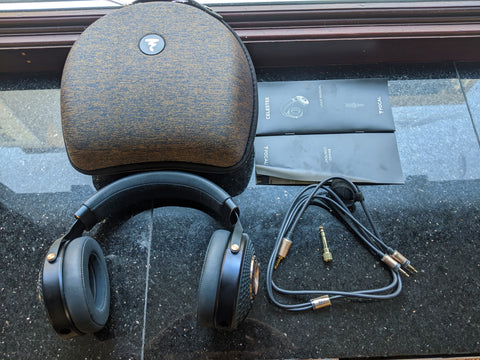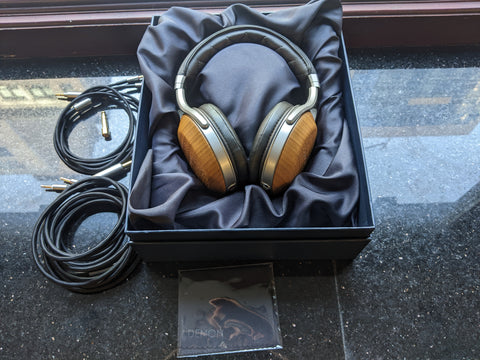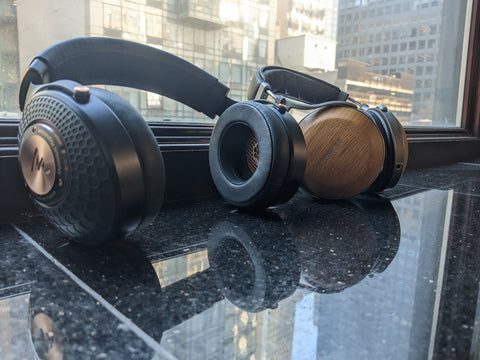Denon D9200 vs. Focal Celestee Comparison Review
by Staff Audio 46
(Updated )
Bookmark this article
Copy to clipboard
Email to a Friend

Denon 9200 vs Focal Celestee Review
I recently had the pleasure of trying Denon's flagship closed-back D9200 headphone. It was a pretty trebly experience, and had me thinking back to my bright impressions of the Focal Celestee. We're dealing with a little bit of a price gap here as the D9200 goes for $1599 and the Celestee for $999, but it's fair to say that both fall in a similar mid-priced high-end territory. If you're like me and like headphones that don't hold back on their highs, you might want to stick around.
What's In The Box?

Focal Celestee
- Focal Celestee
- Headphone Cable with 3.5mm Jack
- 6.35mm Adapter
- Semi-Firm Carrying Case
- Focal Brand Booklet
- Focal Celestee Booklet

Denon D9200
- Denon D9200
- Headphone Cable with 3.5mm Jack
- Headphone Cable with 6.35mm Jack
- 6.35mm Adapter
- Antistatic Cloth
Look and Feel
I'll start this portion by saying that in terms of comfort, you can't go wrong with either. Both headphones use high quality leather and memory foam for ear cup and headband padding that felt great against my skin, especially when coupled with both headphones' fine-tuned headband pressure. The leather on the Denon felt thicker and smoother on the skin, but the Focal's thinner and porous leather provided more aeration. When it comes to passive isolation, the Celestee is the clear winner – not that the D9200 didn't effectively block out sound, but the Celestee's passive isolation is a particularly stand out quality.
In terms of looks, the Denon D9200 is hard to beat with its Japanese bambu wood housing and stitched headband. The Celestee has the pretty standard Focal house look, take it or leave it. Be your own judge, but in my opinion the Denon D9200 is a particularly beautiful headphone with a refined, crafted style. Too bad it doesn't come with a case.
Technical Design and Specs
Focal Celestee
- Driver: 40mm Aluminum-Magnesium Dynamic
- Impedance: 35 ohms
- Sensitivity: 105 dB
- Frequency Response: 5 Hz - 23 kHz
- Weight: 430 grams
Denon D9200
- Driver: 50mm FreeEdge Dynamic
- Impedance: 24 ohm
- Sensitivity: 105 dB
- Frequency Response: 5 Hz - 56 kHz
- Weight: 375 grams
Sound Stage
There are some pretty significant differences to go over in the Denon D9200 and Focal Celestee's stages and images. The D9200 has adequate width with forward-facing narrow depth – a shape I would describe as conical. The Celestee, on the other hand, has incredible width with a shallow depth that I primarily feel wrapping around the back of my head. The size of the headphones' chambers seem to play a big role in this. Listening with the D9200, my ears were significantly closer to the drivers, and its “D” shaped headphone pads leave little surface area exposed – its chamber is closer to a slit than a dome. The Celestee's drivers sat very far from my ears, and the padding gave plenty of room for sounds to reach behind the back of my ears. Ultimately, this round goes to The Celestee. Though the D9200 has it beat in depth, I came away feeling pretty neutral on its imaging and staging; the Focal Celestee's stage actively impressed and entertained me.

Lows
The D9200 and the Celestee have a fairly similar mid bass emphasis in their low ends, but have different ways of contextualizing this emphasis in their balances. The Celestee has a pretty full and balanced sub response backing up its mid bass while the D9200 has some noticeable attenuation in its subs. The Celestee has a fatter bass as a result, but the D9200 seems to have it beat in terms of slam and impact – I experienced that bassy, chest-and-throat feeling from the Celestee only in fleeting moments, while the Denon model had it decent moderation. To sum that in fewer words, Focal's Celestee's low end is deeper and softer, while the D9200 is higher and tighter.
It's worth considering that this perception of their low ends could be a result of their high end balances. The Celestee has plenty of high mids, but the D9200 is a treble machine. The high-mid/high transients punctuating basses and kick drums are exceptionally noticeable on the D9200, making the initial impact of such parts sound hard and tight.
Mids
Both headphones clearly favor high mids in their profiles, the D9200 more than the Celestee. The high mid and high profile on the D9200 is in fact so pronounced that it made the Celestee sound like a warm headphone when I went back to listen with it – luckily, I'm familiar enough with the Celestee to know that this just meant my ears needed a rest. While Focal's Celestee definitely has more low mid presence than Denon's D9200, it nonetheless leans into the higher end of its center frequencies. Generally speaking, both headphones have a fairly balanced low and center mids in the scheme of their overall EQ. The Celestee's low mids likely seemed more present to me due to its steeper cuts and roll off in its highs, which gave the warmth in its middle band more room to be noticed. It's worth noting that the Denon seemed privy to taking vocals and pushing them to the very top of the mix as a result of its center frequency balance, whereas the Celestee had a more even handed approach with vocals.
Highs
The high end is where both of these headphones impart the core parts of their sound signatures. In the case of the D9200, it's drastic, but it's simple: after liberally boosting its high mids, it never looks back. Its high end boost is present well into the 18 – 20 kHz region. More than just emphasizing vocal air or fine reverb details, this results in a bright and driving layer of harmonics that energetically interact and blend with one another, like a treble collage. Depending on the type of listener you are, you're likely reading that with a sense of intrigue or horror. Parts like tambourines or twangy guitars come through forcefully, and the granular, incredibly high pitched tips of vocal rasp and hi-hats become apparent. Perhaps the most impressive and premium quality of this high end is that the D9200 pulls all of this off without painfully boosting sibilants.
The Focal Celestee has a prominent high end that is perhaps a little...bizarre? There's an odd “V” shape in its high frequency profile that boosts high mids, scoops the middle treble range around 5 kHz, and then slowly and cautiously returns to slightly boosted levels in the upper end of its highs. While this provided a spacious high end in contrast to the D9200, it could at times give the higher strings of acoustic guitars a somewhat empty or phasey quality. That said, it brings its treble back up just in time to give a nice expression to their strummy transients. Mid-high scoop aside, the Celestee added plenty of air to vocals and seemed to do particularly well with the buzzy tones of saxophone reeds.
The most important difference between these two headphones is the 4-5 kHz region, as the Celestee's scoop in this region made it significantly softer-sounding than the D9200. Quick note on this: the human ear is “tuned” to hear this particular frequency range with a particular intensity, thus making it a particularly impactful area of a headphone's sound signature.
Overall
This comparison has all but confirmed to me that the D9200 might have the boldest high end of any over-ear closed-back headphone that I've tried. Focal's Celestee is certainly a trebley headphone, but doesn't take the same risks as the Denon D9200. I'm left with the impression that a casual listener is more likely to enjoy the Celestee, while the D9200 has some serious audiophile appeal and seems to belong in a headphone collection rather than as a standalone pair. As for me, I'm quite a fan of the D9200's extreme highs and crafty build, and prefer it's balance to the Celestee's for the vast majority of the music that I listen to.
The Denon D9200 and the Focal Celestee are available for purchase from Audio46.
Get the Latest Headphone News and Reviews in Your Inbox
Subscribe to our newsletter and get 10% off your first purchase!*
*some restrictions may apply


 FREE
FREE 


